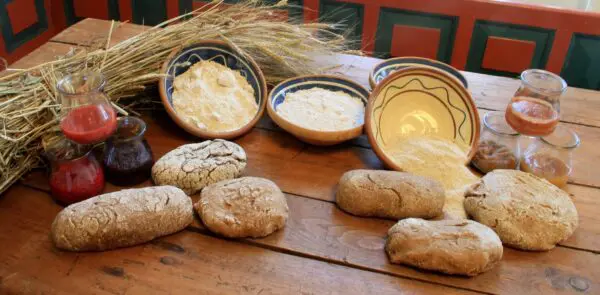The grain and the bread

Grain (and bread) has long been the main food in Denmark.
Grain – has been the main food in Denmark since the Stone Age. Archaeological excavations from settlements show that wild species of wheat (emmer, einkorn and spelt) and barley (six-rowed) were part of the ancient cuisine.
Until the Bronze Age, wheat was the dominant grain, then barley took over. Oat kernels also appear in archaeological material from the Bronze Age. It was not until the Late Iron Age and throughout the Middle Ages that rye was further cultivated.
Wheat cultivation becomes a rarity and rye becomes Denmark's most important grain. Madmor primarily used rye in bread. Wheat and thus white bread belonged to feasts and wealthier households. It was said that "as rye was the most important, wheat was the most festive". But barley also had great importance in the self-sufficient household, as malt was used in home-brewed beer. Oats, on the other hand, were long considered the lowest grain, used unthreshed for pig and horse feed.
Even in the 1830s, rye was called “a staple food for the entire nation”, despite the fact that the country experienced crop failures during several periods of the 18th century, when rye failed and families were hit by poverty and hunger. In the early 19th century, two-row barley first appeared in rectory and manor gardens. The Danish farmer welcomed this new type of barley, as it produced better bread flour, while six-row barley was best suited for brewing beer.
More and more farmers adopted wheat, but it was not until the 1930s that Danish farmers harvested equal amounts of wheat and rye.
From the grain, people prepared bread, porridge and gruel – a basic diet that lasted well into the 19th century with different compositions and cooking methods. In addition to rye bread, which was eaten at all meals, people prepared rye flour porridge or cut the rye bread into cubes and spread it over boiled milk. In connection with slaughter, rye flour and barley groats were included in blood sausages. Barley flour was ground into both flour and groats. The flour was used for bread – while the groats were prepared in soups or gruel. Dishes such as sweet porridge – groats cooked in milk and barley porridge with beer, were well-known meals that the mother served on Sundays. The mother ground oats into flour or groats. She mixed the flour into the rye bread dough and from the groats she cooked soup or the still well-known oatmeal.

Six different kinds of historical bread.
